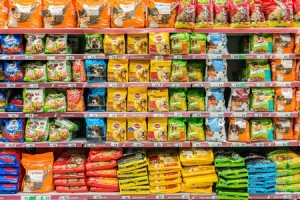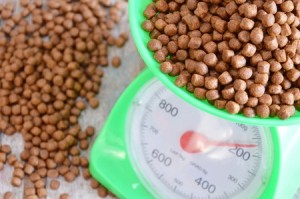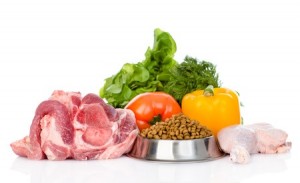
Whether you are looking at dry food or canned wet food, dog food labels contain a lot of information including ingredients and nutritional facts, which can be extremely useful in helping you decide what food is best for your dog. Dog food labels can also provide information about the protein and fat levels in the product, as well as recommended feeding guidelines. But have you noticed that when you’re in a pet food store, grocery store or shopping online it can be a little confusing to understand how to read a dog food label? Like most people who have dogs, you want to make sure that you are giving him the best food that’s available. So here is some information to help you learn how to read a dog food label so you can compare and select which brand or type of food is best for your dog.
Label Overview
Dog food labels, which are the main form of communication between dog food companies and dog owners, are regulated by both state and federal government agencies. Dog food labels need to be approved and registered, and must meet requirements developed by the Association of American Feed Control Officials (AAFCO). The AAFCO, which is not a government agency, is a board of federal and state representatives that regulate and set nutritional standards for the pet food industry. According to their website, the AAFCO works to help “develop and implement uniform and equitable laws, regulations, standards and enforcement policies for regulating the manufacture, distribution and sale of animal feeds”. These guidelines are established in an effort to help protect consumers by regulating the production, labeling and sale of dog (and cat) food.
According to these regulations, there are a total of eight required items that must appear on dog food labels, which is discussed in more detail in the sections below. The front label, which is often referred to as the Principal Display Panel (PDP), is important since it’s the first thing that you see when shopping for dog food products. The brand, the product name, what type of animal the food is made for (dog or cat), and a quantity statement (how much product is in the bag or can) must appear clearly on the front label of the package. If there are labels on both the front and the back of the package, then the remaining four required items can be listed on the back panel. So as you’re learning how to read a dog food label, the following information will help explain a little more about each required item that needs to be on the label.
Product Name
The name of the product is the first thing that you’ll probably notice on the dog food label, as it’s designed to capture your attention and encourage you to purchase the product. While there are no specific regulations for product brand names, the name of the product must be truthful and not contain language that is false or misleading.
As you’re looking at dog food labels, you’ll notice that the wording used in the product name will vary quite a bit. This is because product names change according to the ingredients used in the product, as well as the percent of the ingredients that is contained in the product. For example, product names that include the phrases “Chicken Dog Food”, “Chicken Recipe Dog Food”, “Dog Food with Chicken” and “Chicken Flavor Dog Food” all have very different meanings and also have different rules that they must follow. This is important to pay attention to when you’re learning how to read a dog food label.
The 95% Rule – If a product uses the phrase “Chicken for Dogs” or “Beef and Liver Dog Food”, then at least 95% of the product must come from the named animal source. So “Chicken for Dogs” or “Chicken Dog Food” must contain at least 95% chicken; “Beef and Liver Dog Food” must contain at least 95% beef and liver combined, with beef being the primary ingredient in the product since beef is listed first. Vegetables and grains are not part of the 95% rule, so if the label says “Lamb and Rice Dog Food”, then at least 95% of the product must contain at least 95% lamb. As a side note, this does not include water added for processing. Counting water that has been added, the named ingredient must still make up at least 70% of the product.
The 25% Rule – If a product name uses phrases such as “formula”, “dinner”, “recipe”, “platter”, “nuggets” or “entrée”, then it must contain at least 25% of the named ingredient. This is important to note, because if a product is labeled “Beef Dinner for Dogs”, then only one-quarter of the total product needs to be beef. This means that beef would probably be the third or fourth ingredient in the ingredients list. This is good to know because your dog might not like liver and in this example, this product may actually contain more liver than beef even though it’s not called out in the product name. So part of learning how to read a dog food label includes looking closely at the ingredient list as well as looking at the product name. Also, as with the 95% rule, this does not include water added for processing. Counting the added water, the ingredient listed still needs to make up at least 10% of the product.
The 3% Rule – Another phrase you might see in a product name may include “With Cheese” or “With Beef”. Anytime you see the word “with” in the product name, the product must contain at least 3% of that ingredient. Obviously this can make a big difference if the product is called “Dog Food with Beef”, which would need to contain only 3% beef, whereas a product called “Beef Dog Food” would contain at least 95% beef.
The Flavor Rule – If a flavor is included in the product name, such as “Beef Flavor Dog Food” or “Chicken Flavor Dog Food”, there is no requirement to list the specific percentage, but it still needs to be called out in the ingredient list. In most cases when the word “flavor” is used, the amount of the ingredient used is barely detectable. So where “Chicken Dog Food” would contain at least 95% chicken, “Chicken Flavor Dog Food” would hardly have any chicken in the product.
Purpose: Is It Dog or Cat Food?
The product label must clearly state what type of animal (dog or cat) the product is made for. This could be part of the product name such as “Beef Dog Food” or it could be part of the label description on the front panel. Also, the label needs to clearly identify the purpose of the product, such as whether it is a food or a treat.
Net Quantity Statement
All dog food labels must tell you how much product is in the container, listed in net weight or net volume. This information needs to be clearly visible, and is typically on the lower third of the principal display (front) panel. The net quantity is especially important to know when you’re comparing different brands of dog food – a dog food bag that can hold 40 pounds of dry dog food may actually contains 35 pounds of dog food. Or a 6 oz. can of wet food may really contain 5.5 oz. of product. So even though the bags or cans of dog food may be the same size on the outside, the physical contents inside the package can vary.
Guaranteed Analysis
The guaranteed analysis is the section of the label that tells you the minimum levels of crude protein and crude fat, and the maximum levels of crude fiber and moisture that are in the dog food product. These numbers provide only minimums or maximums, not actual amounts.
It’s important to note that the term “crude” refers to the analysis method used to test the product, and is not a guarantee of the nutritional quality or digestibility. The digestibility of protein and fat, for example, can vary quite a bit depending on the source, so it’s best to look closely at the ingredient list to determine how nutritious and digestible the source really is.
If the dog food product has other guarantees on the label, such as “High in Calcium”, then these guarantees also need to be listed in the guaranteed analysis section of the label. Also, if the product claims to be low-fat, then both the maximum and the minimum percentages of crude fat must be listed in the guaranteed analysis.
As you’re looking at different dog food labels, you’ll notice that the guaranteed analysis for canned dog food looks very different from the guaranteed analysis of dry food. The moisture content of canned food will be much higher than the moisture content of dry food. Dry dog food usually contains only 10-12% moisture (water), and canned dog food will contain between 75-78% moisture. Dog food products that are labeled as “in gravy”, “in sauce” or “stew” will have an even higher moisture content.
Ingredient Statement
All of the ingredients that are in a dog food product must be listed on the label in the order of weight. The ingredient that makes up the highest percentage of the total weight of the product will be listed first, the next highest one will be listed second, etc. So for example, you might see a dog food product that lists in this order “chicken, whole grain corn, chicken meal…” This means that chicken is the ingredient that weighs the most in the product, followed by whole grain corn, then chicken meal, etc. This can be a little tricky, however, when you’re trying to compare products. The weight of the ingredient is based on the total weight, which will also include its water content. So you might see Brand A canned dog food that has chicken listed as the first ingredient, and corn listed as the next ingredient on the label. Then, as you’re comparing products, you might see Brand B dry dog food has corn listed as the first ingredient and chicken meal as the second ingredient. The difference is that Brand A has chicken which can contain approximately 75% water, where Brand B has chicken meal which contains approximately 10% water. So it’s really not fair to try to compare ingredients in different products unless you can compare them on a dry matter basis. Here is one formula you can use to mathematically compare pet food on a dry matter basis.
The ingredients used in dog food must be considered “Generally Recognized As Safe” (GRAS), and any food additives used must be approved for use in animal feeds as defined by the AAFCO. Ingredients also need to be listed by their common or usual name, and most of the ingredients used in dog foods have a corresponding definition in the AAFCO Official Publication. Further down the list of ingredients, you’ll see ingredients that are usually vitamins, minerals or other nutrients. Other ingredients you may see include artificial colors, stabilizers and preservatives, all which should be approved for use and considered safe for animal use.
Nutritional Adequacy Statement
The nutritional adequacy statement is especially important as it guarantees that the dog food meets or exceeds the requirements for the specific life stage that the product was intended. There are AAFCO nutrient profiles for two life stages: one for adult dogs (“Adult Maintenance”) and one for growth, gestation, and lactation (“Growth/ Reproduction”). Adult Maintenance dog food is made for adult dogs with normal activity levels and might not be appropriate for growing puppies or active dogs, such as field dogs or dogs competing in agility. Dog food in the Growth/Reproduction category is designed for puppies and pregnant or lactating female dogs. Another category that dog food companies can market dog food for is called “All Life Stages” and as long as it meets the strict guidelines set for Growth and Reproduction dog food, it could be fed to puppies as well as to adult dogs.
The nutritional adequacy statement is also a guarantee that the dog food product is complete and balanced for your dog. By being “complete”, this means that all of the nutrients required by your dog are included in adequate amounts in the product. “Balanced” means that the nutrients in the product are properly proportioned to one another.
Dog food companies that claim that their product is “complete and balanced” for a specific life stage must verify that this claim is accurate. There are two ways they can do this: either by laboratory analysis alone (called Formulation Method), or by laboratory analysis plus actual feeding trials (called Feed Trial Method). If the company used the Formulation Method, meaning that the product and/or ingredients were analyzed in a laboratory and not actually fed to dogs, then you will see on the label “Product A is formulated to meet the nutritional levels established by the AAFCO Dog Food Nutrient Profiles”.
If the company used the Feed Trial Method, meaning that the product and/or ingredients were analyzed in a laboratory and feeding trials were also conducted, then the label will read “Animal feeding tests using AAFCO procedures substantiate that Product A provides complete and balanced nutrition”. This means that the product was analyzed in a laboratory and was also fed to dogs of the life stage the product is intended for, using the protocols set up by the AAFCO. The Feed Trial Method is known as the Gold Standard and is the preferred method for measuring nutritional adequacy of a dog food product.
Another phrase you might see on labels is “This product is intended for intermittent or supplemental feeding only”. This means that the product should only be fed as a snack or a treat only, and not used as a primary source of nutrition.
Feeding Directions
All dog food labels are required to provide feeding directions explaining how much you should feed to your dog each day. These directions are based on calculated maintenance energy requirements (MER) for a given body weight or body weight range. The feeding directions on dog food labels should be viewed as rough guidelines, however, since dogs have different needs based on their age, breed, energy level and metabolism. The feeding directions will usually have instructions such as “Feed ___ cups per ___ pounds of body weight daily” or “Feed _____ amount of product per ______ of dog.” It’s best to start out giving your dog the amount listed in the feeding directions, and then you can increase or decrease the amount that you’re feeding based on your own dog’s individual needs.
Manufacturer’s Name and Address
The name of the company along with their address should also be listed on the dog food label. Typically you will see the name of the company, the city, state and zip code; companies do not need to put their street address on the label as long as their address is easily found in a telephone directory or by searching online. If the product is made by someone else, you’ll see the words “manufactured for” or “distributed by” in front of the address. Also, dog food labels should include a toll-free number that you can call in case you have any questions or concerns about the product such as the nutrient content, feeding directions, where to buy, etc.
So when you’re at the market or pet food store and you’re trying to figure out how to read a dog food label, look for these 8 required items on the label, and pay close attention to the product name, the ingredient list and the nutritional adequacy statement. Also, it’s always a good idea to speak with your veterinarian about different food options that are appropriate for your dog’s age and lifestyle.










Leave a Reply